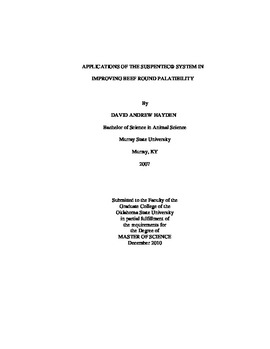| dc.description.abstract | The objective of this study was to determine the influence of the SuspenTec� system on the palatability traits of beef round cuts. In phase I, USDA Select paired beef eye of round (ER, IMPS 171C; n = 17) and bottom round flat subprimals (BF, IMPS 171B; n = 17) were selected and aged for 14 d. Subprimals were then cut into equal halves and randomly assigned to a 20% or 30% suspension of 50/50 beef trimmings incorporated in a brine solution containing salt, phosphate, and antioxidants a control group or test run group. Suspensions containing 30% trimmings improved (P < 0.05) the WBS of BF steaks. No significant (P > 0.05) differences in tenderness in WBS values between treatments was evident in ER steaks. However, there were significant (P < 0.05) improvements in initial juiciness, sustained juiciness, initial tenderness and overall tenderness in both ER and BF when comparing the SuspenTec� treatments to controls. These data concluded that the 20 and 30% suspension treatments showed potential in increasing palatability traits of both subprimal cuts. Though not significant (P > 0.05), the 30% showed tendencies of being more effective than the 20% suspension treatment in terms of improving palatability traits of round cuts. Phase II was conducted using 14 d aged ER (n = 40) and BF (n = 36) subprimals that were either processed using the 30% SuspenTec� suspension (30%), a traditional moisture enhancement (E), or blade tenderization (BT) which were compared to traditional wet aged 14 d control (CON) cuts to determine the effects on WBS, sensory traits and lipid oxidation. No differences (P > 0.05) in WBS of BF or TBARS in either cut were identified. However, consistent differences (P < 0.05) were evident among the various treatments on ER steaks, with E steaks exhibiting the most desirable WBS tenderness with BT and 30% being intermediate followed lastly by the CON steaks. From a sensory standpoint, 30% steaks showed higher levels (P < 0.05) of initial and sustained juiciness compared to BT and CON BF steaks. Even though no differences (P > 0.05) were evident in initial tenderness ratings of BF steaks, panelists rated overall tenderness of non-intact treatments as being more desirable when compared to CON counterparts. Additionally, BT reduced the amount of detectable connective tissue when compared to 30%, E and CON samples. Similarly, 30% and E increased (P < 0.05) the initial and sustained juiciness of ER steaks. Compared to CON ER steaks, all non-intact treatments (E, 30% and BT) improved (P < 0.05) the initial and overall tenderness ratings. These data support that traditionally tough round cuts can be subjected to several non-intact procedures, which ultimately improve overall palatability ratings when compared to traditionally used postmortem aging practices. | |
